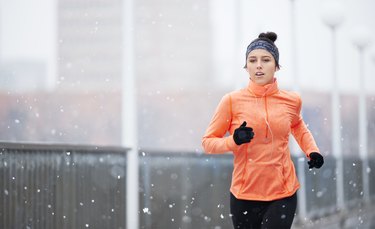
Cold hands can prove bothersome, but icy hands that last for long periods of time and hamper your everyday activities can be worse. Cold, stiff hands and exercise are linked in an interesting way.
Exercise can sometimes be the cause of your glacial sensations, but it can also be the key to treatment in some cases.
Video of the Day
Video of the Day
Causes of Cold Hands
The causes of cold hands while or after you exercise can vary from one person to the next. The weather plays a major role; exercising in the winter may cause severe coldness in both your hands and your feet. Circulation problems might also rear their ugly heads more frequently during a workout.
Raynaud's disease is another possible reason for experiencing cold hands during exercise. Raynaud's is a syndrome in which your hands and feet become very cold, usually in cold weather and sometimes because of stress.
The smaller arteries leading to your fingers and toes narrow, and your extremities respond to the limited blood circulation by feeling cold and numb, according to Mayo Clinic. Your fingers turn white, then blue, then red when you get warmed up again.
Exercise can be a nonmedical, noninvasive form of treatment and prevention for Raynaud's disease. Exercise, in whatever form you enjoy, promotes better circulation and can be a natural stress reliever as well.
Since physical and emotional stress can be triggers for Raynaud's, you may find yourself having more episodes when you are feeling the pressure mount. Increase your level of activity and you may see a decrease in the characteristic cold hands and loss of sensation.
Watch Out for Frostbite
One of the primary dangers of cold hands while exercising outdoors is developing frostbite. Frostbite can cause irreversible damage to your skin tissues. Wearing several pairs of gloves to prevent cold hands is one of the easiest ways to protect yourself against frostbite when you exercise.
Layer thin, insulated or moisture-wicking gloves underneath heavier gloves or mittens that provide warmth against the low temperatures and biting winds. The American Academy of Dermatology suggests wearing insulated mittens or gloves. The bottom line is, protect your hands.
Help Your Blood Circulate
Exercises can help you avoid cold hands by pumping up your circulation. Fist pumps — opening and closing your fists several times — not only help the blood circulate throughout your hands and fingers, they can counter the stiffness you might feel when your hands are cold.
Wrist rotations perform a similar function. Or simply flap your hands back and forth rapidly. Shoulder rotations — hunching your shoulders forward and then backward — can also temper the coldness in your hands and arms.
Other Causes of Cold Hands
There are quite a few not-so-exotic reasons for cold hands and feet after exercise. Aging may be why your hands are cold, says AARP. Getting older makes you feel colder as does losing weight. If you've lost a significant amount of weight, you could find yourself shivering for the rest of your life. That layer of insulating fat kept you warm.
Anemia is another possible culprit. Harvard Health Publishing says that 12 percent of women between the ages of 12 and 49 have anemia in some form or another. If it's a mild case, upping your intake of iron, folic acid and B12 may do the trick.